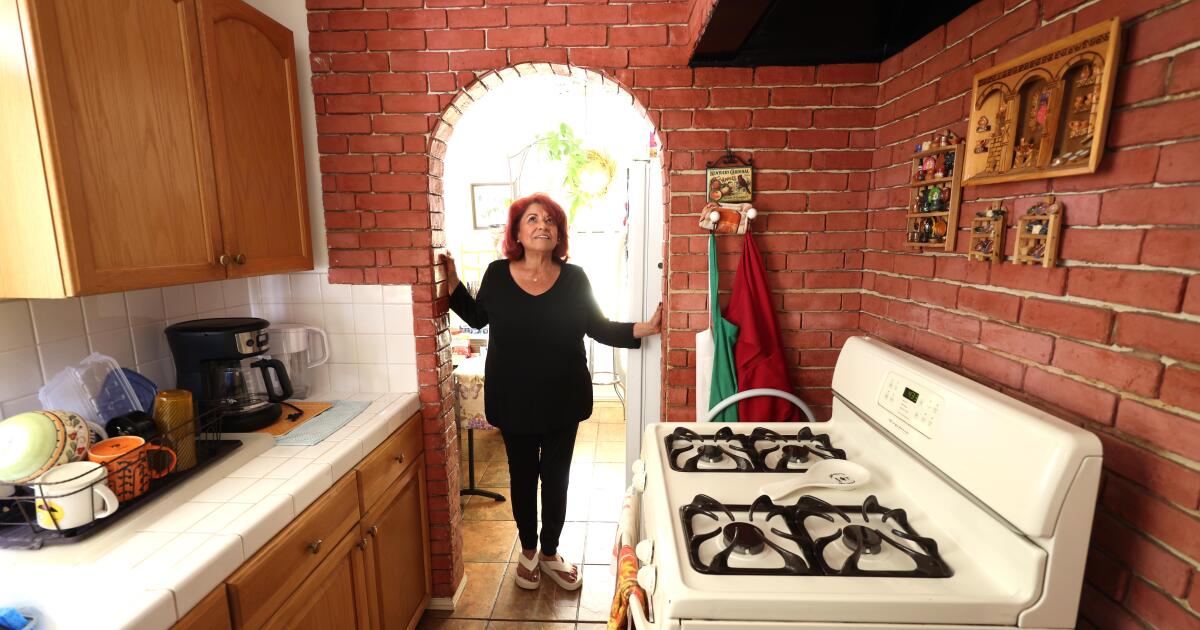For nearly four decades, Patricia Payan has lived in a leased version of the suburban ideal in a two-bedroom, one-bathroom home on Sheffield Avenue in El Sereno.
Payan rents the house from the state of California, one of hundreds publicly owned in the community because of a freeway that was planned but never built. Living there for so long, Payan made countless memories and personal touches at the property. Her son and daughter had their birthday parties in the same backyard where her grandchildren now do. She redid the floors in the kitchen herself and paid for her own gardener.
The one thing missing for Payan was the home’s title. Now, that’s changing. Six years after the freeway was officially declared dead, Payan is in escrow to buy her house from the California Department of Transportation.
“I’ve always wanted this,” said Payan, 77. “It’s a dream to be a property owner.”
Sales of the homes, apartments, lots and other properties owned by Caltrans are the final step toward healing the wound opened in the mid-20th century by plans to complete the 710 Freeway through the San Gabriel Valley. Decades of empty, boarded-up houses and lax oversight have led to blight and grievances against the public agency, exacerbated by Los Angeles’ housing affordability crisis.
Patricia Payan, 77, and significant other Richard Enriquez, 71, converse in the backyard of the Caltrans-owned El Sereno home she has rented since 1986. Payan is now in escrow to purchase it for around $70,000. She’s overjoyed at the chance to own the home where she raised her family and to leave it to her children and grandchildren.
(Genaro Molina / Los Angeles Times)
Caltrans’ tenants, including Payan and other longtime low- and middle-income residents, are gaining the opportunity to buy their homes at reduced prices, the only way they say they could afford to become homeowners. The public agency is selling vacant properties to affordable housing providers who are repairing them for new occupants.
But the continued slow pace of the sales is mounting frustration for Caltrans tenants, city officials and housing advocates looking to reawaken their neighborhoods. Renters fear they may remain in escrow for as long as two years before Caltrans completes repairs to their homes. Some vacant properties have yet to hit the market. Notably, the historic Pasadena childhood home of chef Julia Child has been empty for 40 years, and there’s no timeline for it to be sold.
Jason Brown, who is buying the home in El Sereno he’s rented with his partner since 2007, said he’s tempered his enthusiasm. He’s seen little progress since entering escrow in January.
“I’m going to believe it when I see it,” said Brown, 53.
The 4½-mile gap between the northern end of the 710 Freeway in Alhambra and the 210 Freeway in Pasadena emerged in the 1970s. Other sections of the freeway were built, but South Pasadena activists stalled the full route’s completion. Caltrans already had acquired 460 properties along the corridor it intended to demolish, and the homes sat in limbo until 2018, when state lawmakers killed the freeway.
While the freeway’s fate wended through years of court and political hearings, the transportation agency rented some houses while allowing others to remain vacant and fall into disrepair. By 2015, the agency had listed more than three dozen as uninhabitable. Today, blocks filled with otherwise vibrant small cottages in El Sereno are marred by multiple houses with plywood and “No Trespassing” signs in their front windows.
It’s long been anticipated that if the freeway never got finished, Caltrans would sell the houses, with existing tenants getting first dibs. For those with low or moderate incomes, Caltrans would be responsible for repairs prior to the sale. Even better for the renters, purchase prices would scale with their incomes so that mortgage payments wouldn’t be a burden.
Payan is a retired DMV worker. Brown is a storekeeper for the city of Los Angeles. Other tenants planning to buy their homes include a retired clerk with the county fire department and a retired owner of a small upholstery store.
They said they’ve been quoted $70,000, $143,000, under $400,000 and $38,000, respectively, to buy their homes. Eric Menjivar, a Caltrans spokesperson, declined to confirm the numbers, saying in a response to written questions from The Times that prices aren’t final until the state transportation commission approves them.
The prices are far below what residents could find on the market. Median home values in El Sereno, per Zillow, are $792,000; the average in L.A. County is nearly $100,000 higher. Payan said the discounted sales program gives her an opportunity to become a homeowner that she wouldn’t otherwise have.
“To be able to afford it?” she said. “Oh my God, yes.”
The deals discourage new owners from flipping the properties due to restrictions on resales and financial penalties that are especially stiff in the first five years. Tenants say that’s no problem.
Felix Hernandez, the retired upholstery store owner, and his wife have rented on Sheffield Avenue for 48 years. Their 45-year-old son has schizophrenia and lives with them now.
“My idea was that when we passed on,” said Hernandez, 78, “my son would have a place to stay.”
When Hernandez and the other renters will finalize their purchases is an open question. Tenants said major repairs have yet to begin on their properties.
Brown said the electricity in his house likely needs rewiring. The foundation, he said, is so off-kilter that he plays fetch with his dog by placing a tennis ball on the ground and watching it roll down the slope.
Menjivar said that Caltrans anticipates closing sales to tenants beginning in early 2025. He noted that if a home is deemed too expensive to fix, Caltrans is allowed to offer tenants another one, and the agency is setting aside vacant properties for that purpose.
Many in and around the area don’t believe that the freeway’s scar on the community will fade until the empty homes are filled. About 125 along the corridor, including those in multifamily properties, are vacant, according to Caltrans.
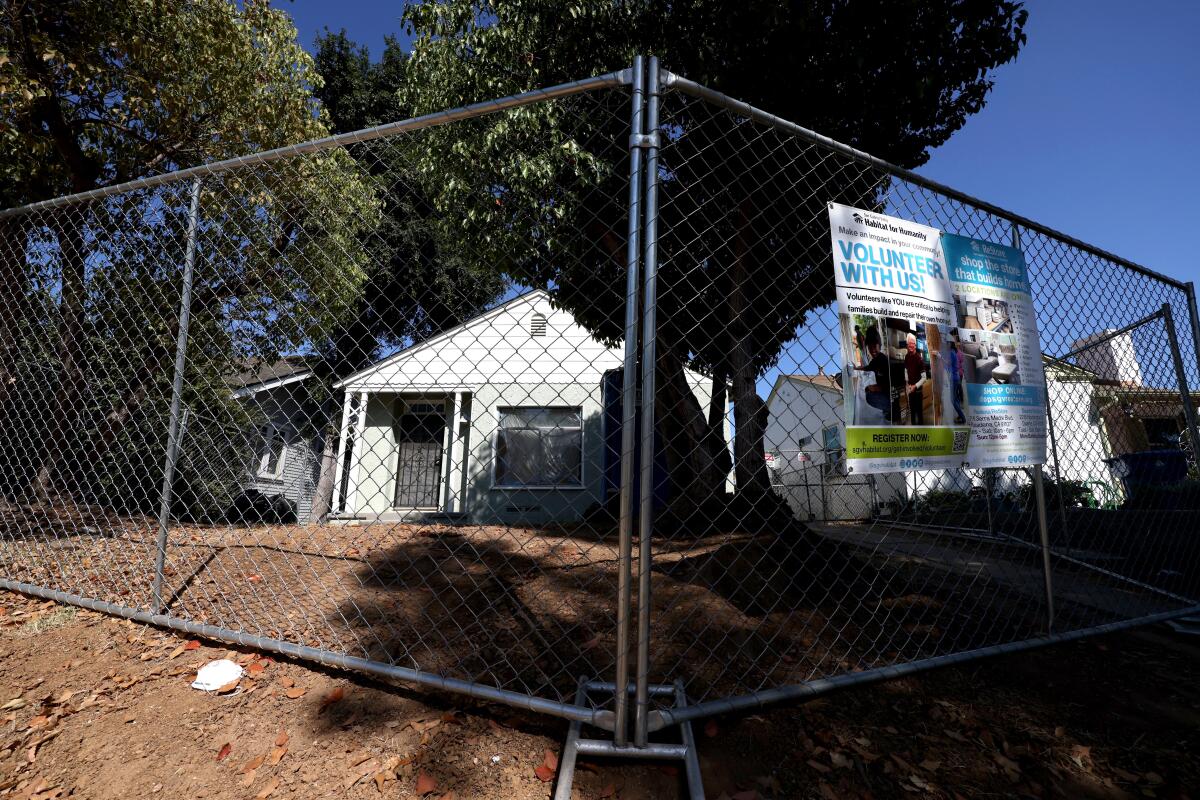
A Caltrans-owned home on Sheffield Avenue in El Sereno, seen late last month, was recently purchased by Habitat for Humanity and was being restored.
(Genaro Molina / Los Angeles Times)
Affordable housing providers and public agencies are buying the homes as is, and they or future homeowners will be responsible for repairs. As a sweetener, these homes cost only what Caltrans originally paid to buy them in the 1960s. Caltrans has awarded three dozen vacant properties in El Sereno to the city housing authority, San Gabriel Valley Habitat for Humanity and other nonprofits. Typical price tags for the homes range from $14,553 to $28,564.
Habitat workers have begun renovations on those that have closed.
Bryan Wong, the nonprofit’s chief executive, said more than 1,000 people have submitted applications to buy the homes. To qualify, families of four have to earn no more than $110,000 annually, with a sliding income scale for households of different sizes. All must have solid credit and $7,500 set aside for a down payment. Habitat plans to reserve half for those already living or working in El Sereno.
Wong, who is 59, grew up in South Pasadena and has been hearing about the 710 Freeway all his life. He’s elated to be helping make the community whole.
“This is not a pipe dream anymore or a what-if story,” Wong said. “This is done. This is happening.”
In Pasadena and South Pasadena, Caltrans is offering vacant homes to the cities, which will then spin them off to third parties. South Pasadena officials had expected to gain control of some homes more than a year ago, but the sales have yet to be finalized.
“We appreciate your patience,” the real estate team hired by the city said on its website. The city expects to close on the purchases this month.
The city of Pasadena has an army of building inspectors and appraisers ready to examine 17 empty homes offered by Caltrans once they’re allowed inside, said Bill Huang, director of the city housing department.
Huang said the city will turn over the homes to Habitat or other nonprofits and may sell some of the larger, historic properties at market rates to finance affordable housing initiatives in the city.
“Having dozens of vacant homes isn’t good for any neighborhood,” Huang said. “We’re not solving the saga of all the Caltrans-owned homes, but we will for 17 of them.”
Menjivar said that despite the complaints about the pace, the agency is pleased with its progress in the past year. About two dozen tenants are in escrow to buy their homes. All the vacant properties Caltrans has awarded in El Sereno have closed or are expected to do so within the next several weeks, he said. The agency anticipates its sales to Pasadena will be final early next year.
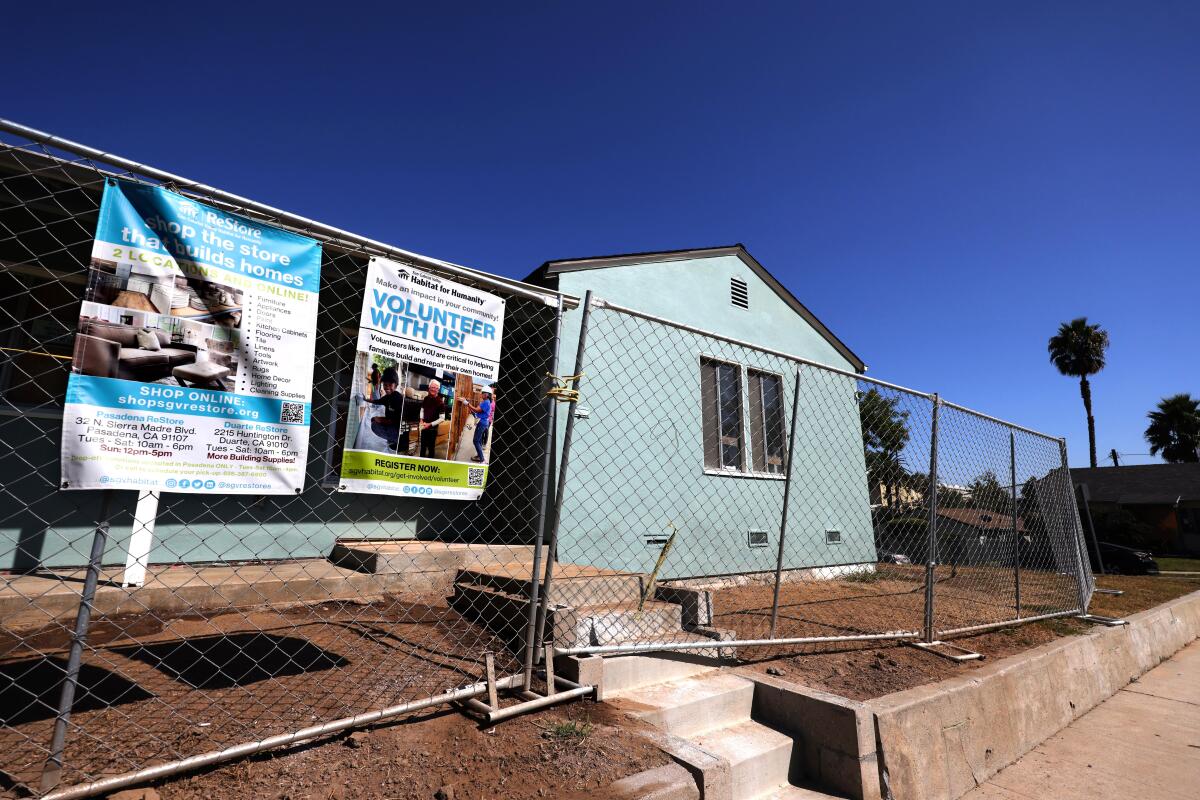
A Caltrans-owned home on Allan Street in El Sereno, seen late last month, was recently purchased by Habitat for Humanity and was being restored.
(Genaro Molina / Los Angeles Times)
For now, Caltrans is still holding back some of the empty houses, including its most famous property.
Built around 1910, the stately, 2½-story, wood, brick and stucco Craftsman home at 1199 S. Pasadena Ave. is where Julia Child was raised. Biographies of the chef include tales of Child sleeping outdoors on the second-floor porch and romping through the lawn with her younger siblings and their Airedale dog named Eric the Red.
On a recent Friday, longtime local preservationists Claire Bogaard and Mic Hansen admired the original, oversized wooden front door and redwood beams on the porch.
“Look at that,” Hansen said. “You’re not going to find these kinds of wood anymore.”
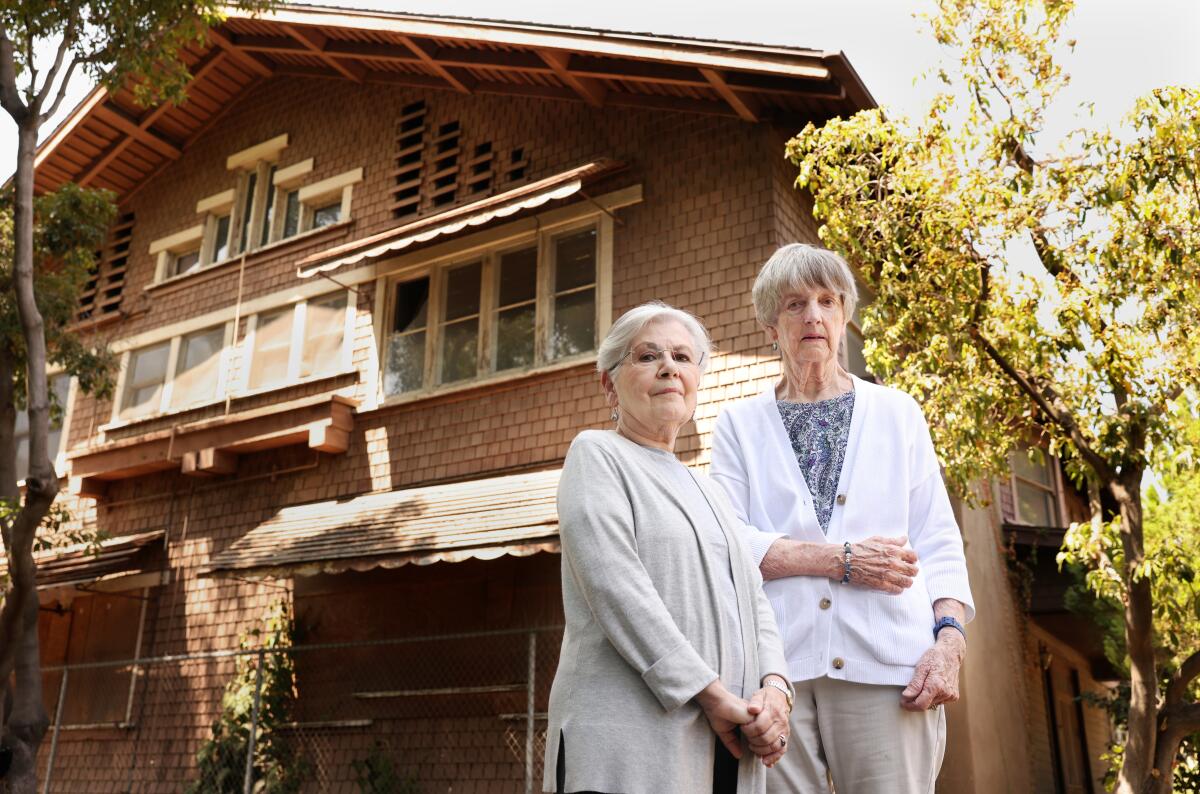
Local preservationists Mic Hansen, left, and Claire Bogaard outside Julia Child’s childhood home in Pasadena.
(Christina House / Los Angeles Times)
Bogaard and Hansen have been behind efforts to secure official historic designations for the Child house and others in the neighborhood as examples of landmark early 20th century Southern California architecture. They lamented the signs of disregard in a home that has remained vacant for so long.
Besides the plywood on the windows, someone had managed to get a large trampoline over the chain-link fence in the backyard and left it there.
“Some of these houses were magnificent,” Hansen said. “It’s sad to see them deteriorate and go unused.”
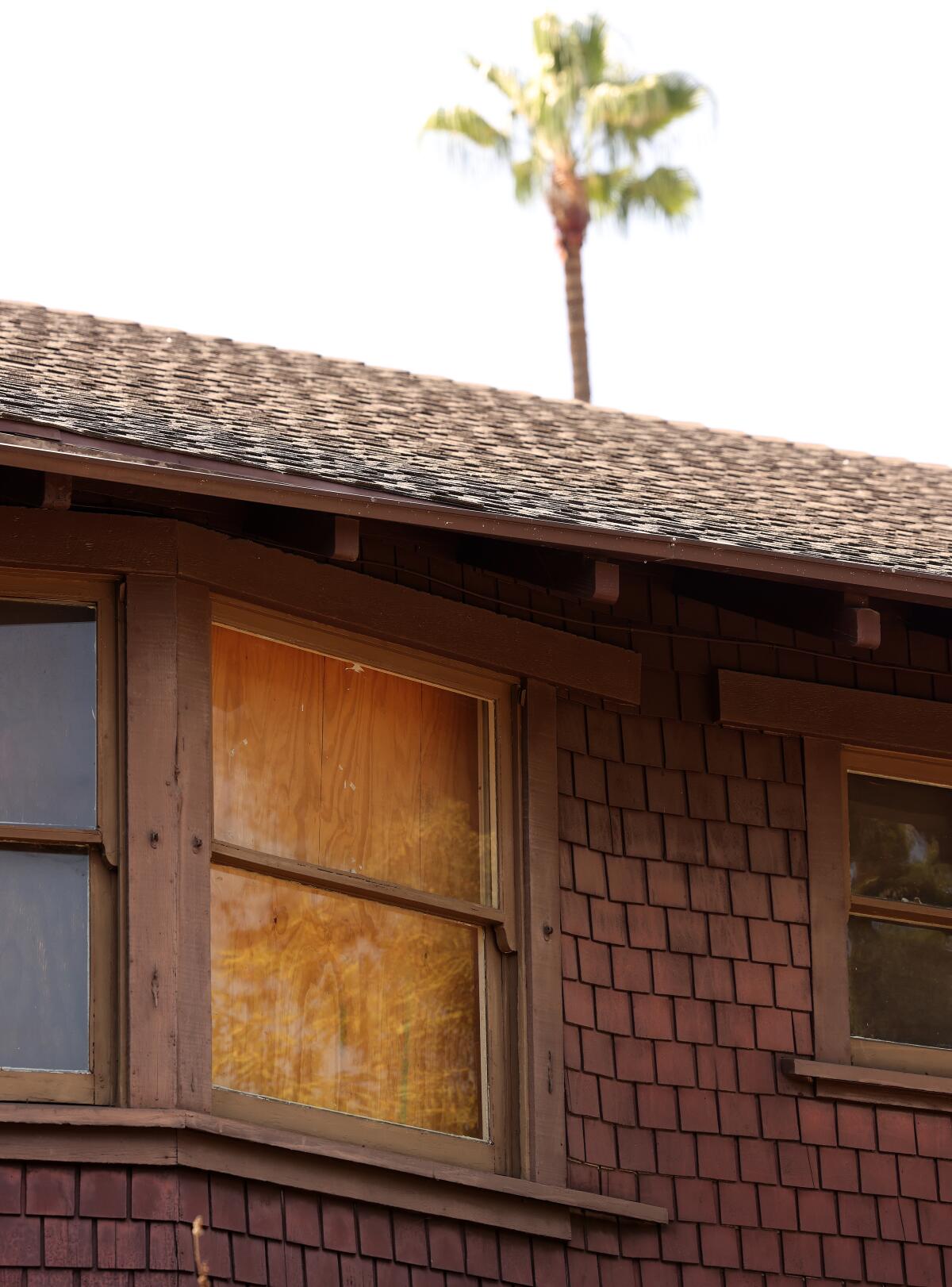
A boarded-up window at Julia Child’s childhood home in Pasadena.
(Christina House / Los Angeles Times)
Menjivar said the Child house and other remaining vacant properties in Pasadena will be offered to the city “in the near future.”
Resentment over the empty houses boiled over in spring 2020. Homeless and housing-insecure residents seized a dozen of the vacant homes in El Sereno in a coordinated protest against the lack of state action to house the most needy. The activism succeeded, as Caltrans leased two dozen of its properties to the city housing authority for the protesters, who called themselves Reclaimers, and other homeless residents to pay rent and live in the homes legally for two years.
For the Reclaimers, those two years expired in late 2022, but seven households remain. The housing authority has pending eviction lawsuits against them.
Tina Booth, the L.A. housing authority’s director of asset management, said that the agency continues to offer assistance and buyouts to the Reclaimers but that the terms of the agreement require them to leave.
“We are trying to encourage folks to continue to work with us so that they can land in supportive housing or other affordable units and so that they’re just not simply displaced,” Booth said.
More broadly, she said, her agency is expanding its commitment to low-income housing in El Sereno through the vacant properties it’s buying from Caltrans. The housing authority plans to refurbish single-family homes and add accessory dwelling units so that more people can live as tenants there.
The public agency’s stance frustrates Sandra Saucedo, a Reclaimer facing eviction. She said that the housing authority shouldn’t be forcing out people who need housing — Saucedo sometimes sells her plasma for income — and that instead housing officials and Caltrans should allow them to remain by selling the properties to a community land trust.
Two Reclaimers who recently accepted the housing authority’s $15,000 buyout offer have returned to homelessness. Saucedo, who was living in her car before she occupied a home, fears the same fate.
“It’s very scary,” said Saucedo, 42. “From one day to the next, you could lose everything.”
